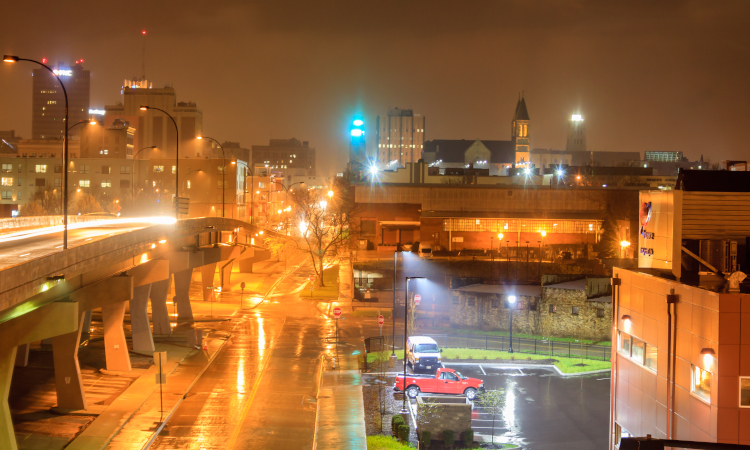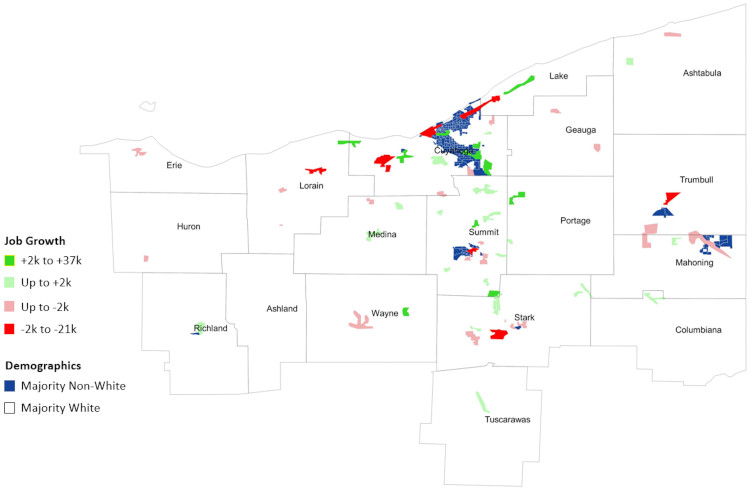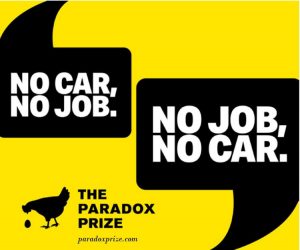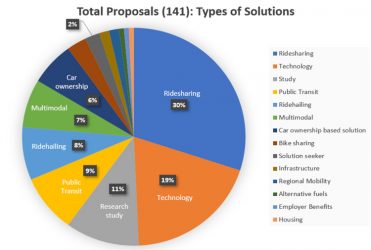“No car, no job; no job, no car”: tackling an economic paradox
- Like
- Digg
- Del
- Tumblr
- VKontakte
- Buffer
- Love This
- Odnoklassniki
- Meneame
- Blogger
- Amazon
- Yahoo Mail
- Gmail
- AOL
- Newsvine
- HackerNews
- Evernote
- MySpace
- Mail.ru
- Viadeo
- Line
- Comments
- Yummly
- SMS
- Viber
- Telegram
- Subscribe
- Skype
- Facebook Messenger
- Kakao
- LiveJournal
- Yammer
- Edgar
- Fintel
- Mix
- Instapaper
- Copy Link
Posted: 13 October 2020 | Dominic Mathew - Fund for Our Economic Future (FundNEO) | 1 comment
In the ongoing endeavour to rebuild Northeast Ohio’s (USA) economy to ensure inclusive growth and opportunity for all residents, limited workforce mobility represents both a symptom of a decades-long problem and an obstacle in achieving this goal. Dominic Mathew, Urban and Regional Planner (Mobility Innovations) at the Fund for Our Economic Future (FundNEO), explains more.


Downtown Akron in Ohio - one of the region's covered by the Fund for Our Economic Future (FundNEO)
Improving job access has been a focus for the Fund for Our Economic Future for more than a decade. The Fund is a consortium of philanthropic, civic and business entities aligned toward equitable growth and opportunity for an 18-county region that includes Cleveland, Youngstown, Elyria, Akron and Canton. Within the Fund’s threefold strategy of job creation, job preparation and job access, access to jobs includes two complementary efforts: bringing jobs to people and bringing people to jobs.
While the Fund pursues a long-term job hubs strategy1 to develop concentrated areas of traded-sector (industries that sell goods and services outside their local market) employment, getting to jobs that pay a living wage is an immediate need, especially for low-income residents and communities of colour.
The work of the Fund and its partners highlights that long commutes and lack of transportation options not just prevent access to a job, but also to a livelihood. Combined with sprawling development, this leaves much of the region’s workforce with a seemingly insurmountable transportation paradox: no car, no job; no job, no car.
A uniquely disconnected region
As Northeast Ohio developed in the past decades, its outward physical expansion was unsupported by economic or population growth. This no-growth sprawl, typical of many midwestern U.S. cities, strains under-resourced public transit systems to reach jobs that are farther away from where people live.
This region is uniquely disconnected compared to similar metropolitan areas. A 2015 study released by the Brookings Institution2 ranked Cleveland last of 96 metropolitan statistical areas (MSAs). Surrounding MSAs in Akron and Youngstown (ranked in the bottom 20 per cent) highlight the spatial mismatch in the region. Between 2000 and 2012, the number of jobs near where people live in the Cleveland MSA fell by 27 per cent. In high-poverty neighbourhoods with low car ownership and high transit usage, this figure rose to 35 per cent.


A map of Northeast Ohio representing job hubs in the region, tracking population and number of jobs from 2002-15. The dark blue areas indicate majority population of communities of colour, red indicates high job losse (Credit: FundNEO based on American Community Survey data)
This disconnect has real costs: people spend more time and money commuting, if they can get to a job at all; businesses struggle to fill open positions; municipalities spend on infrastructure to support new development while having to maintain the underutilised assets left behind; and our environment suffers as air quality declines due to long, car-based commutes. Ultimately, our regional economy loses its competitive edge.
How we got to where we can’t get anywhere
While the factors contributing to this landscape over the past several decades are myriad, a primary influence was the facilitation of, and reliance on, car-based transportation and infrastructure to the detriment of all other transit options. Systemic racial segregation policies, abundant greenfields and municipal tax incentives contributed to this job sprawl.
The situation may seem ideal for residents with cars, but for low-income residents, the widening physical distance between home and work has expanded other gaps – in wages, opportunity and access to child care, health care and other necessities. This disparity stunts the growth of Northeast Ohio, with the lion’s share of the burden falling on communities of colour.
Distance discrimination
The region’s traditional transit systems are under-resourced and stretched thin, serving an expanding area with low population density, and fall short of efficiently reducing the distance between people and jobs. So, while business booms in Solon, a southeastern suburb of Cleveland with profuse greenfields and municipal tax incentives, a carless Cleveland resident 16 miles away faces a one-way bus commute of two hours with multiple transfers.
As a car-free resident of Cleveland and a regular transit rider, I meet numerous fellow commuters who have no choice but to rise at dawn and endure long commutes to work. Northeast Ohio residents face these untenable choices: hours of commuting by public transit each day, an expensive commute by car that can consume more than an hour’s worth of wages or a significantly smaller set of employment options. For many, these challenges make their world smaller and reduce the economic opportunities they can access.
The Paradox Prize


It’s the classic chicken-or-egg paradox, but in transportation terms: if you have no car, you can’t get a job. If you have no job, you can’t buy a car (Credit: FundNEO)
In June 2019, the Fund and its partners announced a public-facing competition inviting innovative solutions to this transportation paradox. The Paradox Prize sought big ideas to help Northeast Ohioans who are stranded economically by their geography. The ideas would connect these individuals to open positions with paths to family-sustaining wages.
The Fund for Our Economic Future, National Fund for Workforce Solutions, Cuyahoga County, the Lozick Foundation, the Cleveland Foundation and DriveOhio pooled $1 million to support up to 15 pilot projects through the Paradox Prize. The selection was spread over three rounds with awards ranging from $20,000 to $100,000, depending on the needs and potential impact of each project.
A regional Mobility Advisory Committee comprising leading experts in transportation, city planning, workforce and community development and philanthropy in Northeast Ohio evaluated initial proposals – a concise 300-word application. Finallists presented a business plan pitch to the committee.
The criteria for evaluating proposals prioritised solutions that:
- Are simple, practical and user-friendly
- Connect people to jobs and improve workforce mobility in the region
- Are affordable and financially sustainable beyond the pilot phase
- Are measurable and demonstrate impact
- Are potentially scalable and replicable
- Align to site and user context (urban, suburban or rural environments, or different user groups)
- Focus on low-income residents and communities of colour.


One-third of paradox Prize applications aimed to test ride-sharing in some way or form. Technology played a key role, with proposals advocating for sensor technology to virtual skilling sessions during a commute (Credit: FundNEO)
We recognise that $1 million is insufficient to transform the transportation landscape for Northeast Ohio’s four million residents, but our intention is to catalyse innovative mobility solutions that can transform the region and lead to better business engagement on worker mobility, policies that limit sprawl and encourage multimodal services.
Travelling office hours
The Paradox Prize is not a ‘theatre of innovation’ with no tangible outcomes. I held regular ‘office hours’ across Northeast Ohio which helped to situate our previous research with on-ground reality. These interactions allowed us to understand unique transit challenges faced by different communities, brainstorm potential solutions and coalesce like-minded collaborators. Relying on an under-resourced transit network to travel across the region reinforced the many hurdles riders must endure.
These trips were invaluable to understand the real-world implications of the issues framed in the decade-plus of research on this topic. Several early learnings influenced how we proceed:
- Transportation is not the sole barrier to job access. Reliable and affordable child care, skill training and housing remain top challenges for accessing jobs.
- Employee transportation considerations surface too late in business location decision conversations, if at all. Site selection strategies need to address these issues and problem-solve with companies before decisions are made. Employers would benefit from a toolkit highlighting different mobility options and federally offered pre-tax transportation benefits.
- Communities understand the needs of their constituents but lack the technical and financial resources to identify and implement solutions from existing programs.
- Mobility solutions are constantly changing, and transit agencies need to pivot their offerings to maintain a balance between public service and effective systems that embrace multimodality and provide equitable access. Most transit agencies in Northeast Ohio submitted Paradox Prize applications to test innovative services in light of strict regulatory guidelines and lack of state innovation funds.
- There are many communities and businesses that lie outside a transit-rich area and cannot access services because of an unsafe environment or lack of infrastructure to cover the first and last mile of a trip. Potential solutions include circulator services, connectors, bike-sharing, e-scooters, improved bike or pedestrian infrastructure, and safer bus shelters. We must address this gap and incentivise this connectivity that can lead to more people using transit.
A pandemic pivot
By January 2020, the selection committee had announced funding for eight pilot projects. When COVID-19 effectively shut down the state of Ohio in March, most Paradox Prize pilots were put on hold, both for the safety of participants and as a result of the uncertainty and variability around workplace adaptations. To sustain transit support during this time, the Paradox Prize leveraged its existing platform to help match non-profit organisations experiencing increased mobility needs with public transportation assets that might be able to support them due to a reduction in regular service.
As the pandemic continues to shift how work gets done in Northeast Ohio, investors in the Paradox Prize are examining how to refocus and restart pilots to serve both the immediate and long-term needs of the communities they serve. Flexibility, inclusion and innovation will remain critical to our success.
Find out more
Discover the projects and pilots that have launched across Northeast Ohio thanks to Paradox Prize funding in Dominic Mathew’s follow-up piece here.
References
- jobhubsneo.org
- “The growing distance between people and jobs in metropolitan America”; The Brookings Institute May 2015 ; measured by number of jobs within the median commute distance of the center point of each census tract. Median commute based on Cleveland MSA commuting patterns
Biography
Dominic Mathew is an architect-planner who works on addressing mobility and job-access challenges in Northeast Ohio with an economic development collaborative, the Fund for Our Economic Future. He manages The Paradox Prize, that invests $1 million workforce mobility pilots and aims to eradicate the transportation paradox of ‘no car, no job; no job, no car’. Previously, he was part of the Institute for Transportation and Development Policy’s (ITDP) India office. He has a Bachelor of Architecture from the Birla Institute of Technology, Mesra, India and a Master’s in Regional Planning with a focus on Environmental Finance and Impact Investing from Cornell University, Ithaca, USA.
Related topics
Mobility Services, Public Transport, Workforce Inclusivity
Related cities
Ohio
Related organisations
Fund for Our Economic Future









Great piece. Happy to share our progress w/our Solon Mobility Task Force inspired by Senator Matt Dolan w/great partners ie., GCRTA, NOACA, Nestle, Cleveland Clinic, Wrap Tite, Swagelok, Tri-C, Solon Chamber of Commerce.
Mayor Kraus